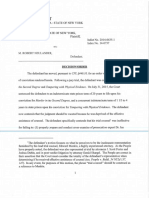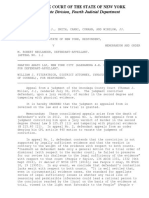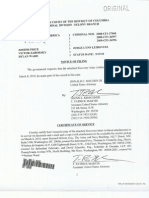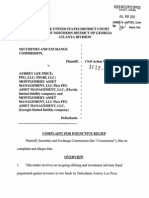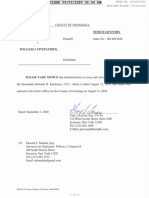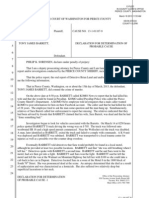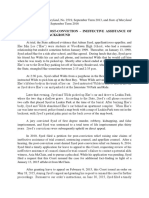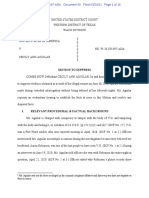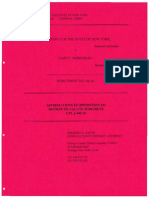0 ratings0% found this document useful (0 votes)
1K views22 pagesNeulander Court Papers
Court papers in case against Robert Neulander.
Uploaded by
cnycentralnewsCopyright
© © All Rights Reserved
We take content rights seriously. If you suspect this is your content, claim it here.
Available Formats
Download as PDF or read online on Scribd
0 ratings0% found this document useful (0 votes)
1K views22 pagesNeulander Court Papers
Court papers in case against Robert Neulander.
Uploaded by
cnycentralnewsCopyright
© © All Rights Reserved
We take content rights seriously. If you suspect this is your content, claim it here.
Available Formats
Download as PDF or read online on Scribd
You are on page 1/ 22
}
COUNTY COURT
COUNTY OF ONONDAGA STATE OF NEW YORK
THE PEOPLE OF THE STATE OF NEW YORK,
-against- Indictment No. 2014-0635-1
Index No. 14-0737
M. ROBERT NEULANDER,
Defendant.
APPEARANCES: WILLIAM J. FITZPATRICK, ESQ.
District Attorney of Onondaga County
MELINDA McGUNNIGLE, ESQ., of counsel
Attorney for the People
EDWARD Z. MENKIN, ESQ.
J. SCOTT PORTER, ESQ.
Attorneys for the Defendant, M. Robert Neulander
MILLER, Thomas J., Presiding
DECISION/ORDER
The defendant was indicted by an Onondaga County Grand Jury for
Murder in the Second Degree and Tampering with Physical Evidence. The
defendant subsequently moved to suppress tangible physical property
which was taken from his home on September 17, 2012. On January 23,
2015, the Court held an evidentiary hearing. The People called four
witnesses: DeWitt Fire District Lieutenant William McGarrity and three
members of the Town of DeWitt Police Department - Officer Chase
: O7FALES
Bilodeau, Officer Michael Kurgan and Sergeant Thomas Norton.’ The
defendant also testified on his own behalf. The parties also consented to
the post-hearing submission of three items: a log sheet indicating the
times at which all emergency and law enforcement personnel entered the
defendant's home on September 17, 2012, a copy of the Town of Dewitt
Police Department Operational Manual, and a January 26, 2015 letter
from Dr. Robert Stoppacher, the Medical Examiner for Onondaga County.
The Court now makes the following findings of fact and conclusions of
law.
FINDINGS OF FACT
From the credible testimony adduced at the hearing, the Court finds
that on September 17, 2012 at approximately 8:27 a.m., members of the
DeWitt Fire Department, Rural Metro Ambulance Service and the Town of
DeWitt Police Department were dispatched to 6916 Shalimar Way in the
Town of DeWitt regarding an unconscious person. It was unknown if the
Person was breathing, and the caller had stated that there was “blood
everywhere”. The Fire Department engine arrived at the residence first
and parked in the street. Rural Metro's ambulance arrived next and
pulled into the driveway. As soon as Lieutenant McGarrity opened the
door of the fire engine, he heard a female (later identified as Jenna
‘At different times after September 17, 2012, both Bilodeau and Kurgan
were promoted to the rank of sergeant.
PePAIBE
Neulander, the defendant's daughter) hysterically screaming for help.
Jenna appeared on the sidewalk in front of the house and led McGarrity
and his crew members inside the house, to a stairway, and into the
upstairs bedroom of the injured party (later identified as Leslie
Neulander, the defendant's wife).
Upon entering the bedroom, McGarrity saw the defendant kneeling
over Mrs. Neulander. Mrs. Neulander was covered in a robe from the
shoulders down. It appeared that her body was wet, her left eye had a
dark bruise, and there was blood around her head, The defendant
indicated that his wife had fallen in the shower. Rural Metro paramedic
Jamie Pienkowski confirmed that Mrs. Neulander had no pulse and was
not breathing. Emergency workers then began to administer CPR to the
decedent. Shortly after the workers began efforts to resuscitate Mrs.
Neulander, the fire chief then asked the defendant to step out of the
room and the defendant complied with the request.
Officer Bilodeau was the first police officer to arrive at the home at
Shalimar Way, at approximately 8:32 a.m. The fire truck and ambulance
had already arrived at the home. Bilodeau, who was wearing a police
uniform, let himself in through the front door of the home and heard
crying and screaming. Bilodeau followed the noise and went upstairs. He
then observed the defendant and Jenna Neulander on the floor, crying
and comforting each other. Bilodeau walked a few feet past them into the
O7F1I67
bedroom, and saw that emergency personnel were working on the
decedent. Bilodeau observed a trail of blood from the bathroom to the
Mrs, Neulander’s location in the bedroom. Bilodeau ensured that the
scene was secure and did not approach the decedent or enter the
bathroom at that time.
Shortly thereafter, McGarrity and the defendant had a conversation
in the sitting area outside of the bedroom. McGarrity asked for
permission to terminate life-saving efforts based upon Mrs. Neulander’s
condition. The defendant indicated that he wanted to speak to his
brother, a physician, before terminating rescue efforts. Jenna was
“hysterical”, and a police officer offered to take a cell phone from Jenna
and find the number for the defendant's brother. Jenna provided police
with a password for the phone.” A few minutes later, the defendant gave
McGarrity permission to cease efforts to save Mrs. Neulander’s life, and
she was pronounced at 8:42 a.m. Fire Department and Rural Metro
personnel left the scene shortly after the pronouncement.
After Mrs, Neulander was pronounced, McGarrity informed Bilodeau
that the decedent had fallen in the bathroom, sustained injuries, been
moved next to the bed in the bedroom, and then lifesaving efforts had
commenced. Bilodeau then walked into the bathroom and observed
2
The Court finds that at a subsequent time, Jenna requested that
police return the phone and it was indeed returned to her within a
reasonable time period.
o7vAt6s
blood on the bathroom walls. The water was still running in the shower,
there were drops of blood in the shower, and the rug was “mussed up”.
Bilodeau also walked into the bedroom and observed the decedent's
body. Bilodeau was in the area of the bedroom and bathroom for
approximately three to five minutes. At approximately 8:37 a.m.,
Bilodeau briefed Sergeant Norton, who had arrived at the scene a few
minutes earlier. Norton subsequently made several phone calls in order
to notify his duty chief, the District Attorney's Office and the Medical
Examiner's Office of the death. Norton also requested that an evidence
technician respond to the scene.
At Norton's direction, Bilodeau spoke with the defendant and Jenna.
Bilodeau explained that an evidence technician was going to process the
scene and asked the defendant and Jenna to move to the kitchen area.?
Both the defendant and Jenna agreed to do so, and walked downstairs to
the kitchen. Once in the kitchen, Bilodeau explained to the defendant
and Jenna that he would act as a liaison between the family and the
police. Bilodeau explained that he would remain at the home until the
body left the house and that he would update them as to the nature of
the investigation. In addition, Bilodeau asked questions of both the
defendant and Jenna regarding their observations from that morning.
3
To the extent that the hearing testimony of Bilodeau and the
defendant contradict each other regarding the nature of their discussions,
the Court credits Bilodeau’s version of events.
a
O7FA169
Nether the defendant nor Jenna ever asked to return to the sitting room
area or requested that police leave the home at any time.
Shortly after 9:00 a.m., evidence technician Michael Kurgan arrived
at the home. Before he entered the home, Kurgan saw the defendant
and a younger man sitting in the driveway. The defendant made eye
contact with Kurgan and did not say or do anything to prohibit Kurgan
from entering the home. Kurgan subsequently entered the home, met
with Norton, and did a walk-through of the area where the decedent had
been found (the bedroom, bathroom and connected sitting room).
Norton also updated Kurgan as to the information that had been made
available to police. Kurgan noticed blood throughout the carpeting, on
some of the walls, on the stairs leading to the bathroom, and on the
bathroom floor. Kurgan observed that the decedent was laying down on
a backboard in the bedroom.
Kurgan began processing the scene by photographing areas of
interest. He also marked relevant items with a placard and videotaped
the scene as well. He later collected biological samples from the shower,
a sample of a cup of coffee that had been on the bedroom night stand
and two open bottles of water that had also been on the night stand.*
Kurgan also collected a blood swab from the back wall of the bedroom
4
Kurgan explained that he wanted to collect these items because it was
important to know what the decedent had ingested prior to her death,
6
o¢Fad7o
near the light switch and a blood swab from the wall above the clock in
the bedroom, and took measurements of blood spatter on a slanted wall
near the decedent's bed. Both Kurgan and Norton explained that
evidence technicians usually work closely with the medical examiner’s
office in processing scenes. An investigator from the medical examiner's
office also collected some prescription bottles from the bathroom, and
Kurgan had conversations with Dr. Stoppacher, the Onondaga County
Medical Examiner, regarding some of his observations.°
After collecting the evidence, Kurgan transported it back to the
police department. Kurgan left the home at approximately 12:30 p.m.
He did not process other areas of the home because his superiors advised
him that the death had been deemed accidental. When Kurgan carried
evidentiary items out of the home, neither the defendant nor his family
members voiced an objection. Any persons who were present in the
kitchen would have been able, from their vantage point, to see Kurgan
walk down the staircase and exit the home.
Bilodeau was not involved in processing the scene, but he did go
5
In a January 26, 2015 letter to defense counsel, Dr. Stoppacher
indicated that he believed that he left the residence shortly after the
transport company had been called at 11:04 a.m. The log sheet prepared
by the Town of DeWitt Police Department (regarding persons who entered
and exited the residence on September 17, 2012) indicates that Dr.
Stoppacher left the scene at 11:33 p.m. Regardless of the precise time that
Dr. Stoppacher left the residence, it is apparent that after he had
determined the cause of death to be accidental and left the home, Kurgan
continued to take photographs and collect evidence.
ORAL
back and forth to the upstairs bedroom at times. Bilodeau spent the
majority of his time with the defendant and Jenna in the kitchen, and was
present at the home for a total of approximately four hours. The
defendant appeared to be emotionally upset and frequently nodded
and/or gave short answers in response to comments or questions from
Bilodeau.
At some point in time, Bilodeau and Investigator Jason Law went to
look in the defendant's bedroom. Prior to doing so, Bilodeau obtained
express permission from the defendant to look in the room. Neither
Bilodeau nor Law seized any evidence from the defendant's bedroom.
During the time that Bilodeau was present at the home, other
family members and friends arrived. All of the civilians, including the
defendant, were permitted to roam freely about the house, but were
asked not to enter the bedroom, bathroom or sitting area where the
decedent was found. No one registered an objection to this request. The
family specifically requested that they be allowed to see the decedent's
body before it was removed from the home. When the body came
downstairs on a gurney, it was left in the hallway for a short time so that
the family could say their good-byes. The family did not make any other
requests of Bilodeau. Neither the defendant nor any other family
members ever voiced any objections to the presence of police or any
police actions that were undertaken at the scene. Moreover, no one ever
. OVFAVZ2
asked the police to leave the residence. Once the decedent was removed
from the home, the police left within an hour. Before he left, Bilodeau
expressed his condolences to the family and advised them that he might
need to follow up with more questions in the future.
CONCLUSIONS OF LAW_
The burden of proof lies with a defendant who challenges the
admissibility and seeks the suppression of physical evidence. It is he who
must convincingly show that said evidence was searched for and seized
from him in an unlawful manner and, therefore, should not be introduced
against him at trial. Nevertheless, it is the People who bear the initial
burden of showing the legality of police conduct at its inception (see
People v. Wesley, 73 NY2d 351; People v. DiStefano, 38 NY2d 640)
The defendant argues that evidence was recovered as a result of a
warrantless search of his home, and should be suppressed. There is a
general presumption that a warrantless search of an individual’s home is
unreasonable (see, People v. Hodge, 44 NY2d 553), and the People
have the burden of showing that a warrantless search of a home was
justified by a preponderance of the evidence (Colorado v. Connelly, 479
US 157). In the present case, the defendant has conceded that under the
emergency doctrine outlined in People v. Mitchell (39 NY2d 173, cert
denied 426 US 953), the initial entry by police and other emergency
WeFAd73
personnel into the defendant's residence was lawful because the primary
motivation of those who entered the home was to provide medical
assistance to a person in distress. The defendant contends, however, that
the Court should suppress all evidence subsequently recovered because
the emergency ended once the decedent was pronounced. The defendant
also contends that police did not obtain a search warrant prior to
recovering evidence from the decedent's bedroom suite and that no
exception to the warrant requirement was applicable to the facts at bar.
At the outset, it is clear to this Court that the circumstances of the
reported, unattended death of Mrs. Neulander were filled with emotion,
confusion and ambiguity upon the arrival of the DeWitt Police
Department, DeWitt Fire Department, and Rural Metro emergency
workers.
There are, however, multiple streams of authority that exist for this
entry and warrantless search by the Town of DeWitt Police. It is the
Court’s opinion that they merge to provide that the entry and search of
the Neulander residence were proper and appropriate under all of the
attendant circumstances.
Whether express or implied, the Town of DeWitt Police had the
defendant’s consent to do exactly what they did at the Neulander
residence and they did so in a search limited in scope and duration to the
exigencies of the situation that they were invited into.
ee ovvatza
Moreover, as a matter of public policy, the Town of DeWitt Police
Department acted in a manner that was entirely reasonable given the
unique circumstances of this case. Given that the police were asked to
assist with a grave emergency, it would be unreasonable and unrealistic
to expect them to wear blinders and not act upon what they saw,
incidentally and in plain view, while they were attempting to assist in
saving a human life.
A. The defendant consent earch of the decedent's bedr:
suite.
Initially, the Court finds that the defendant consented to a search of
the decedent's bedroom suite.° Consent to a search is voluntary “when it
is a true act of the will, an unequivocal product of an essentially free and
unconstrained choice.” (People v. Gonzalez, 39 NY2d 122). Whether a
party has voluntarily consented to a search is a determination which must
be ascertained after a review of the totality of the circumstances of the
facts at bar. There is no single factor which will be determinative of
6
The testimony established that Bilodeau advised both the defendant
and Jenna Neulander that an evidence technician would be processing the
scene. As a co-occupant of the home, Ms. Neulander would have had
apparent authority to consent to a search of the premises, especially in light
of the fact that the defendant did not refuse consent (see, e.g., People v.
Carter, 30 NY3d 279; People v. Fells, 279 AD2d 706, Iv denied 96 NY2d
758). There was no indication at the hearing that Jenna Neulander ever
registered an objection to the actions of police regarding the processing of
the scene.
" oveAses
consent. Moreover, the form of the consent may be oral, written, or
implied by a party's specific conduct (see, e.g., People v. Putnam, 50
AD3d 1514, lv denied 2008 Lexis 4671; People v. Montana, 298 AD2d
934, Iv denied 99 NY2d 561; People v. Washington, 209 AD2d 819, Iv
denied 85 NY2d 944). Consent may also be formulated through a
combination of words and conduct (see, e.g., People v. Johnson, 46
AD3d 276, Iv denied 10 NY3d 865).
An analysis of several relevant factors leads the Court to the
conclusion that the defendant consented to continued police presence in
his home on September 17, 2012, including the processing of the scene
and the collection of evidence in the suite of the home where the
decedent was found. Here, the defendant was not at any time in police
custody or under arrest when he spoke to Officer Bilodeau on the day in
question. There were no threats, or any behavior on the part of Bilodeau
or other members of the police department which could be described as
coercive or deceptive. The defendant was at all times cooperative with
the investigation. Moreover, although there was no testimony that
Bilodeau warned the defendant that he could refuse to give consent, it
was not necessary that the defendant be apprised of this right (see,
Schneckloth v. Bustamonte, 412 US 218).
While the defendant may have been emotionally upset given the
circumstances of his wife's death, his emotional state did not leave him
12 -
OVALE
incapable of rational thought or the ability to understand what police were
asking of him.’ Thus, even if the defendant did not expressly consent to
a search of the decedent’s bedroom suite, he impliedly consented to the
search by failing to object to the presence of officers or their ongoing
activities after his conversation with Bilodeau (see, e.g., People v.
Smith, 239 AD2d 219, lv denied 90 NY2d 911).
Moreover, the scope of the search in this case did not exceed the
terms of the defendant's consent. The test of measuring the scope of a
person’s consent is a standard of objective reasonableness, which
requires a court to ascertain what a reasonable person would have
understood by the interaction between police and the consenting party
(see, People v. Gomez, 5 NY3d 416; see also People v. Mitchell, 211
AD2d 553, Iv denied 86 NY2d 738). Here, the defendant was advised
that an evidence technician would be coming to process the scene - a
scene replete with blood, where the defendant’s wife had recently
succumbed to a violent death. A typical reasonable person would have
understood such an advisement to mean that police officer would be
potentially taking photographs of the decedent and the area in which she
was found, taking appropriate measurements, and collecting items of
evidentiary value (such as samples of blood, or substances that the
7
The defendant himself testified at the hearing that although he was
distraught, he was capable of remembering things (Hearing Transcript, at.
P, 228-229).
OPVAV??
decedent might have recently ingested) in order to verify the manner and
cause of her death.
Accordingly, the Court finds that the People have met their burden
of proving that “the consent was, in fact, freely and voluntarily given”,
and that this was not a case of “mere acquiescence” to a false claim of
lawful authority (see, Bumper v. North Carolina, 397 US 543, 548-
549).
B. Any investigation pertaining to the decedent’s bedroom suite was
li by and reasonably related to the exigencies of the situation.
Even if the defendant had not consented to the search of the
decedent’s bedroom suite, the Court would find that any seizure of
evidence by police was limited by and reasonably related to the
exigencies of the situation.
The defendant correctly states that no “crime scene exception” to
the warrant requirement exists (Flippo v. West Virginia, 528 US 11;
Mincey v. Arizona, 437 US 385). When police respond to a
constitutionally protected area in response to an emergency, however,
they may “subject the premises to a preliminary search and inspection
whose scope and duration must be limited by and reasonably related to
the exigencies of the situation (People v. Cohen, 87 AD2d 77, 83, affd
58 NY2d 844, cert denied 461 US 930). Once an emergency is over, the
police can not continue to search for evidence under the emergency
14 478
o7
exception (see, e.g., People v. Matta, 76 AD2d 844).
The emergency doctrine allows for a warrantless seizure in a home
when three prerequisites are present. “First, ‘the police must have
reasonable grounds to believe there is an emergency at hand and an
immediate need for their assistance for the protection of life or property’
(citation omitted)”. “Second, ‘the search must not be primarily motivated
by intent to arrest and seize evidence’ (citation omitted)”. “Third, ‘there
must be some reasonable basis, approximating probable cause, to
associate the emergency with the area or place to be searched’ (People
v. Molnar 98 NY2d 328, 332, quoting
Mitchell, supra at
177-178).
As noted above, the defense has conceded that the first factor
under Mitchell was present, since the police lawfully entered the
defendant's home in response to the 911 call regarding the decedent.
With regard to the second Mitchell factor, the Court agrees with the
assertion by the People in their responding affidavit that the actions
undertaken by Kurgan were not motivated by an intent to arrest and
seize evidence, but rather by an intent to preserve the scene and
investigate circumstances that were clearly not a result of a natural
death, illness or disease.* Moreover, under Brigham City v. Stuart (547
8
The Court reaches this conclusion despite Norton’s testimony before
the Grand Jury that he went into “homicide mode” after the decedent's
pronouncement. The Court finds this phrase was used as a matter of
15
OWI
US 398), it is unnecessary to inquire into the subjective motivations of
police when determining whether there has been a violation of a party's
rights under the Fourth Amendment of the United States Constitution
(see also, People v. Desmarat, 38 AD3d 913, 914-915, Iv denied 9
NY3d 482).
Indeed, under any reasonable interpretation of their duties, the
DeWitt Police Department had an obligation to maintain the scene for the
medical examiner? given that Mrs. Neulander’s death appeared to involve
a form of violence, regardless of whether it was “criminal, suicidal,
accidental, intentional or unintentional” and that the death had occurred
in a “suspicious, unusual or unexplained fashion” (see Article IV of the
Town of Dewitt Police Department Operational Manual [Deaths Reportable
to the Medical Examiner]). In accordance with the Operational Manual,
officers on scene were also required to notify a superior officer, preserve
the scene, and determine the circumstances surrounding the incident
(Article VI). While the police here did not work at the Medical Examiner's
direction, their role was to work in conjunction with the Medical Examiner
and his staff. Indeed, the Court of Appeals has recognized that police do
not always function in the traditional criminal arena, but may act “as
speech, and that the police treated this matter as a suspicious death rather
than as a homicide.
°
The medical examiner had a statutory obligation to investigate the
circumstances of Mrs. Neulander’s death in accordance with County Law
§§673 and 674.
16 o7¥1180
public servants in the name of protecting public health and safety”
(People v. Molnar, supra at 742). Given that the police and the Medical
Examiner's staff were essentially performing the same task in attempting
to determine the cause and manner of Mrs, Neulander’s death, the
“interdictions of the Fourth Amendment would apply equally to both”.
Id. at 742.
Finally, the Court concludes that the police had a “reasonable basis,
approximating probable cause, to associate the emergency with the area
or place to be searched”. The defendant also argues that even if
members of the DeWitt Police Department were entitled to be present in
the bedroom suite after the decedent had been pronounced, suppression
is still required because it was not established at the hearing that the
incriminating character of any of the seized evidence was immediately
apparent.'°
Under the “plain view” doctrine, the police can make a warrantless
seizure of contraband, evidence or other instrumentalities of a crime if
the police are lawfully in the position from which the object is viewed, the
police have lawful access to the object and the object's incriminating
nature is immediately apparent (People v. Diaz, 81 NY2d 106; see also
People v. Brown, 96 NY2d 80).
10
Inherent in this argument is a claim that in order to seize evidence
under the emergency doctrine, the requirements of the plain view doctrine
also had to be satisfied.
a7 o7Fi4el
The defendant contends that the incriminating nature of the items
seized here was not immediately apparent. The plain view doctrine does
not, however, require “certainty or near certainty” as to the incriminating
nature of the items (see, e.g., People v. Taylor, 104 AD3d 431, Iv
denied 21 NY3d 914). Indeed, it “merely requires that the facts
available to the officer would warrant a man of reasonable caution in the
belief that certain items may be contraband or stolen property or useful
as evidence of a crime; it does not demand any showing that such a
belief be correct or more likely true than false. A practical, nontechnical
probability that incriminating evidence is involved is all that is required”
(People v. Taylor, supra, quoting Texas v. Brown, 460 US 730, 742
[internal quotation marks and citation omitted]), In the instant case, a
person of reasonable caution would have believed that blood found in the
shower and on the walls of the bedroom, as well as beverages possibly
imbibed by the defendant shortly before her death, would have provided
an indication as to the cause and/or manner of Mrs. Neulander’s death."
i
The presence of the blood on the walls of the bedroom was, at a
minimum, inconsistent with the indication that the decedent had fallen in
the shower. Notwithstanding the Medical Examiner's original opinion that
the cause of death was accidental, such an observation would have
warranted a man of reasonable caution in believing that Mrs. Neulander’s
death had not taken place in the manner which was described to McGarrity,
as well as the belief that such samples could have constituted evidence of a
crime. In light of the Medical Examiner's determination at the scene that
the death was accidental, it likely would have been impractical for the
police to obtain a search warrant in an expeditious fashion.
18 O7FI188
In determining that the actions of police were appropriate here, the
Court is also guided by the similarities between this case and the facts
involved in People v. Neulist (43 AD2d 150). In Neulist, police
responded to a call from a man indicating that he had found his mother
dead in her bedroom. After arriving at the residence, a pillow, pillowcase
and sheet were removed from the decedent’s bed. Police then made a
preliminary determination that the decedent had died from natural
causes. The body of the decedent was removed and an autopsy
conducted. Several of the officers who had responded to the call left the
residence, while others remained at the residence in order to secure the
decedent’s bedroom. Within an hour, detectives were informed that a
bullet had been found in the brain of the decedent. The detectives
returned to the home and conducted a warrantless search of the
premises, which led to the recovery of certain items of evidence.
On appeal, the Appellate Division, Second Department determined
that the initial recovery of evidence was lawful and that the subsequent
search was an extension of the initial investigation. The Second
Department focused on the fact that there was a continued police
presence on the scene as well as the relatively brief lapse of time
between the removal of the body and the continuation of the
investigation.” The Second Department also indicated that “{c]learly
2
It is unclear if the second search in Neulist would be still be
O7FA183
there had been a violent death and it was logical to assume that a crime
had been committed and that evidence of that crime might still be on the
premises” (Neulist, supra at 154).
In People v. Cohen, infra, police received a call indicating that
someone had been shot inside an apartment. The police arrived at the
apartment and discovered the decedent lying in bed with an apparent
gunshot wound. The defendant informed police that the decedent had
shot himself. The police seized the gun found on the bed, two notes
found in open view in the bedroom, two live rounds and a spent shell
casing. Officers left the scene later that day. The following morning, the
medical examiner's office notified police that an examination of the
decedent's wounds led to a possibility that he had been the victim of a
homicide. Several hours later, police went back to the apartment and
conducted a warrantless search of the premises, which led to the
recovery of incriminating items. On appeal, the Appellate Division,
Second Department determined that the items recovered should have
been suppressed, finding that the preliminary investigation had come to
an end and noting that the premises had not been secured by a
continuous police presence. As the People have noted, however, the
Second Department upheld the admissibility of the evidence that was
considered appropriate in light of Mincey v. Arizona (437 US 385) and its
progeny. Nevertheless, it is largely an academic point, since the police
maintained a continuous presence at the scene in this case.
20 oat
initially seized, when police were under the impression that the decedent
had committed suicide.
Here, the police maintained a continuous presence at the scene,
the search was close in temporal proximity to the initial entry of the
premises, and the importance of the items seized was readily apparent to
police. Thus, the collection of evidence was proper even if the emergency
had abated (see,
People v. Desmarat, 38 AD3d 913, Iv denied 9 NY3d 482; People v.
George, 7 AD3d 810, Iv denied 3 NY3d 674; People v. Paul, 15 Misc3d
1128[A], affd 74 AD3d 1239, Iv denied 15 NY3d 923; People v.
Chumbley, 10 Misc3d 1051[A]). The Court therefore finds that under all
of the attendant circumstances, the search of the decedent's bedroom
suite area was limited by and reasonably related to the nature of the
situation presented in both duration and scope.
Finally, the People have also argued that a separate exception to
the warrant requirement - commonly referred to as “exigent
circumstances” - applied here. The exigent circumstances doctrine is
related to the emergency exception, but specifically allows police to act
without a warrant where police possess probable cause to search but
“urgent events make it impossible to obtain a warrant” in where evidence
could be easily removed or destroyed (People v. Knapp, 52 NY2d 689,
695-696; see also People v. Perez, 202 AD2d 319).
Based upon the defendant's conversation with McGarrity, as related
2 y7F1A 85
to Bilodeau, police were apprised that Mrs. Neulander had fallen in the
shower. There was biological material found in the shower, although the
water was still running and could have destroyed the evidence. As the
People have argued, the material could have flowed down the drain. With
respect to the blood found on the walls of the bedroom, the People
correctly noted that it could have been easily cleaned or destroyed.
Similarly, the beverages taken by police from the decedent's nightstand
could have also been easily discarded. Thus, time was of paramount
importance in preserving the integrity of these items. Thus, the Court
also finds that unusual nature of this situation justified a warrantless
search of the items in question under the “exigent circumstances”
exception.
Conclusion
Based upon the foregoing, the Court finds the police conduct
proper in all respects and the defendant's motion to suppress is therefore
denied in its entirety. The decision herein constitutes the Order of this
Court.
ee —
Dated: February 18 2015 Bras J
OMAS 3. MILLE!
Onondaga County Court Judge
a o'2FAt 86
yaaa
aay
You might also like
- Judge Miller's Decision Denying Neulander A New TrialNo ratings yetJudge Miller's Decision Denying Neulander A New Trial14 pages
- Anthony Broadwater Syracuse NY Conviction Vacated. Read: State v. Claude Garrett (CIU) ReportNo ratings yetAnthony Broadwater Syracuse NY Conviction Vacated. Read: State v. Claude Garrett (CIU) Report53 pages
- Milke - Motion To Suppress (W-Exs A Thru G) 080813No ratings yetMilke - Motion To Suppress (W-Exs A Thru G) 080813139 pages
- Oral "Nick" Hillary Motion For DocumentsNo ratings yetOral "Nick" Hillary Motion For Documents9 pages
- Lavine V Fitzpatrick Decision (9-1-20) Defamation Lawsuit Against DA Fitzpatrick Evid. Affidavit of Russ JohnsonNo ratings yetLavine V Fitzpatrick Decision (9-1-20) Defamation Lawsuit Against DA Fitzpatrick Evid. Affidavit of Russ Johnson6 pages
- Order Finding Kimberly Kessler CompetentNo ratings yetOrder Finding Kimberly Kessler Competent10 pages
- Police News Release On Death of Riad HamadNo ratings yetPolice News Release On Death of Riad Hamad2 pages
- Northwestern DA Findings in Fatal July 2013 ShootingNo ratings yetNorthwestern DA Findings in Fatal July 2013 Shooting14 pages
- Lawyers For Adam Montgomery File Appeal of Murder Conviction in His Daughter's DeathNo ratings yetLawyers For Adam Montgomery File Appeal of Murder Conviction in His Daughter's Death101 pages
- Adnan Syed Case: Post-Conviction Appeal AnalysisNo ratings yetAdnan Syed Case: Post-Conviction Appeal Analysis138 pages
- Nassau County District Attorney's Office Motion To Uphold IndictmentNo ratings yetNassau County District Attorney's Office Motion To Uphold Indictment53 pages
- Tudor Chirila Criminal Complaint-Compressed100% (1)Tudor Chirila Criminal Complaint-Compressed26 pages
- Karl G. Eisen v. Philip J. Picard, 452 F.2d 860, 1st Cir. (1971)No ratings yetKarl G. Eisen v. Philip J. Picard, 452 F.2d 860, 1st Cir. (1971)8 pages
- Judge Cannone Denial On Karen Read Motion To Dismiss100% (2)Judge Cannone Denial On Karen Read Motion To Dismiss24 pages
- G.R. No. 144937. February 26, 2004. People of The Philippines, Appellee, vs. Nicanor ALZAGA, AppellantNo ratings yetG.R. No. 144937. February 26, 2004. People of The Philippines, Appellee, vs. Nicanor ALZAGA, Appellant10 pages
- Thibodeau, Gary Motion Filed 7-30-2014 - UpdatedNo ratings yetThibodeau, Gary Motion Filed 7-30-2014 - Updated192 pages


